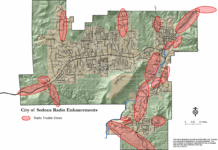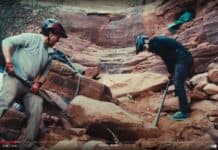Expect traffic on Interstate 17 to get heavier.
With the state’s estimated population growth over the next 20 years adding considerable strain on the existing highway, Arizona Department of Transportation is planning projects now to compensate.
Consultants and ADOT presented a Design Concept Report on Sept. 21 in the Village of Oak Creek, the last of three presentations in Northern Arizona.
The long-range plan’s projects stretch more than 40 miles from just south of the State Route 179 interchange to the Interstate 40 interchange in Flagstaff.
The interstate widening and upgrades are slated because projected traffic volumes will exceed current roadway capacity by 2035, design consultant Jackie Noblitt said. The current road is also inconsistent with current ADOT design guidelines.
Road work is still not expected to be in full swing for several years and won’t be completed until the projected date of 2035. ADOT is looking to complete the planning phase and submit plans to the Federal Highway Administration by early 2012.
ADOT conducted engineering and environmental studies on improvements and alternatives. The design guidelines are in compliance with Coconino National Forest Management Plan, Noblitt said.
The report broke the project into two major areas and three spot locations.
Three alternatives were presented for the mainline portion of hilly terrain from the State Route 179 interchange to the scenic overlook.
The recommended alternative widens the existing roadway to three lanes. A second alternative would realign the roadway to the west, reducing the grade to 5 percent while a third alternative would add more gentle curves and reduce the grade to 4 percent. Both the second and third alternatives would add several miles to the highway, Noblitt said.
The next mainline portion covers the rolling terrain from Milepost 313.5 to Milepost 340.0. Most of the work along this stretch involved straightening curves and how to best incorporate a third lane.
 The spot location projects in the upper area include the John Wesley Powell Boulevard and State Route 89A interchange at Milepost 337.4 and the Woods Canyon bridges at Milepost 317.0.
The spot location projects in the upper area include the John Wesley Powell Boulevard and State Route 89A interchange at Milepost 337.4 and the Woods Canyon bridges at Milepost 317.0.
In the lower area, the main spot project is the State Route 179 interchange. Due to the steep ramp grades of 6 percent to 8 percent, ADOT proposed a realignment and the addition of either traffic signals or roundabouts on either side of Interstate 17, where the exit and entrance ramps meet State Route 179.
The roundabout alternative is the recommended design, being consistent with the rural environment and less expensive, Noblitt said.
Environmental consultant George Ruffner discussed impacts to water quality and biology.
The design incorporates best management practices for waterways and erosion control. The Arizona Game and Fish Department is collecting elk data which will be compared with ADOT crash data to finalize a wildlife accident reduction study.
The American bald eagle and Mexican spotted owl inhabit the area, so the project will aim to disturb their habitats as little as possible, Ruffner said.
“We are going to use every square inch of existing roadway that we can,” Ruffner said, to avoid encroaching on wildlife habitats.
The comment period has been extended to Friday, Sept. 30, Kirby said. Comments can be made at http://www.azdot.gov/highways/projects/I17_SR179_to_I40/Index.asp.



















